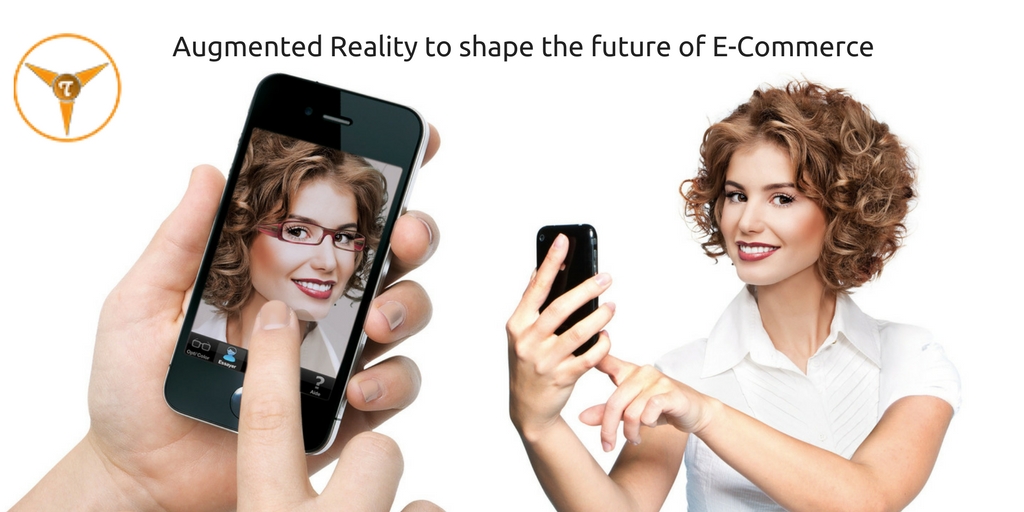
Augmented Reality to Shape the Future of E-Commerce
Tech-experiments come up with much newer technologies that again use as reactants for latest tech-inventions. And such an innovation is AR- Augmented reality, the twin of VR-Virtual Reality. It is quite obvious to be familiar with VR that demands a headset to pick up us from the real world and drop-off at a virtual world offering a unique tour experience. However, unlike VR, AR uses the smartphone camera to mutate the real world around you into a virtual canvas full of candid virtual objects. Using computer vision, AR creates a perfect virtual environment with surroundings looking like real that changes their size and angle as per your phone camera’s movement. As of now, the AR technologies implementation in our day-to-day life is not at its full but it is worthwhile to take a look. However, E-Commerce App Development ground is the first one to show up the best possible AR of recent times.
Augmented Reality(AR) and Virtual Reality (VR) Then and Now
Augmented Reality (AR) and Virtual Reality (VR) have dramatically transformed from niche technologies to mainstream phenomena, deeply influencing how we interact with the digital and physical worlds. The journey of AR, in particular, is a fascinating story of technological evolution and persistence.
In the early 1990s, AR was a nascent field of study, primarily explored in specialized settings. One of the pioneering efforts came from the U.S. Air Force's Armstrong Laboratory. Researchers there developed an early AR system with a complex setup, utilizing bulky hardware and intricate calibration processes. This early AR technology was groundbreaking, but its practical use was limited due to its cumbersome nature and the technological constraints of the time.
Despite the promise of AR, it took years of further research and development before the technology began to find its way into everyday life. Early commercial attempts to simplify AR technology and make it accessible for broader use faced significant challenges. The most notable early consumer-facing AR device was Google's Project Glass, or Google Glass, introduced in 2013. While innovative, Google Glass struggled with issues related to privacy, limited functionality, and social acceptance, leading to its eventual discontinuation.
However, the concept of AR continued to evolve. In the mid-2010s, AR began to gain traction in consumer applications, driven by advancements in mobile technology and computing power. One of the breakthrough moments for AR came with the release of "Pokémon GO" in 2016. This mobile game, developed by Niantic, blended the digital and physical worlds by allowing players to hunt for virtual Pokémon in real-world locations using their smartphones. "Pokémon GO" not only showcased the potential of AR to engage users in novel ways but also demonstrated its capacity to create shared experiences and encourage physical activity.
Another significant milestone in AR development was the introduction of Snapchat's lenses, which allowed users to overlay virtual elements such as filters and animations onto their real-time selfies and video streams. These lenses became immensely popular, highlighting how AR can be used for creative expression and social interaction.
The technology continued to advance, and in 2017, Apple made a significant contribution to the AR landscape with the launch of iOS 11 and ARKit. ARKit is a framework that allows developers to build AR experiences for iPhones and iPads. By leveraging the device's camera, motion sensors, and powerful processing capabilities, ARKit enables apps to seamlessly blend virtual objects with the real world. This development provided a powerful and accessible platform for developers to create sophisticated AR applications, further driving the adoption of the technology.
In parallel, VR technology has also progressed significantly. Unlike AR, which overlays digital information onto the real world, VR immerses users in entirely virtual environments. Early VR systems, like the bulky headsets of the 1990s, were expensive and limited in their capabilities. However, recent advancements have led to the development of more affordable, high-quality VR headsets with improved resolution, tracking, and interactivity. Companies like Oculus (now part of Meta), HTC, and Sony have played pivotal roles in making VR a viable and engaging medium for gaming, training, and simulation.
The synergy between AR and VR has opened up new possibilities for both technologies. AR enhances our interaction with the real world by adding digital layers, while VR provides fully immersive experiences. Together, they represent a new frontier in how we experience and interact with digital content.
As AR and VR technologies continue to advance, they hold the potential to revolutionize various aspects of our lives, from entertainment and education to healthcare and beyond. The ongoing innovation in these fields promises even more exciting VR developments, making the future of AR and VR an area of great anticipation and potential.
AR in E-Commerce
Nowadays, E-commerce App Developers enhance their mobile application implementing Augmented Reality technology to enhance user satisfaction. This is a trial to offer much more homely shopping experience just like traditional marketing. In past, everything we bought is tried and tested regarding its color, size and direction that new age e-commerce app missed out. But worry no more, recent mobile apps are prompting users to try an object before buying. For example, there is an e-commerce mobile app called “Pepperfry”- an online furniture mart. This app uses AR techniques to let users virtually place any furniture in their room to check- “how it’s looking” and also share its picture with friends.

Smartphone Camera- an AR mirror
Taking AR in to social usage, many social applications like Facebook, Instagram and many more use this AR to let users have fun and amusement with their selfie. Here, users can add virtual objects like animals, flowers, makeup, eyewear and many more. However, besides social enactment, AR can do lot more. Getting the power of AR, many makeup and eyewear e-commerce app s are using AR to create an online trial room.
The online eyewear giant “Lensekart” uses AR to create exact 3D of yours within seconds, tracking your facial features through your system camera. And thereafter it will show all available products on your 3D to let you select the most relevant one. Check out here.
Find your Friend in Crowd with AR
In recent past, an American artist Jeff Koons designed an engaging iOS mobile app “NEON APP” using AR very smartly. This app aids you to find out your friend in crowd and helps to locate a store, commercial buildings near you with a down-arrow mark.

More To Come in Future
The wide potential of Augmented Reality is yet to be fully exploited. With the innovation off ARKit by apple, it offers an open platform for app developers to create even smarter and better AR apps blending real and virtual world indiscernibly. The journey from the real to the augmented has just begun. Welcome to the Augmented World!

















 Whatsapp
Whatsapp
 Email
Email


